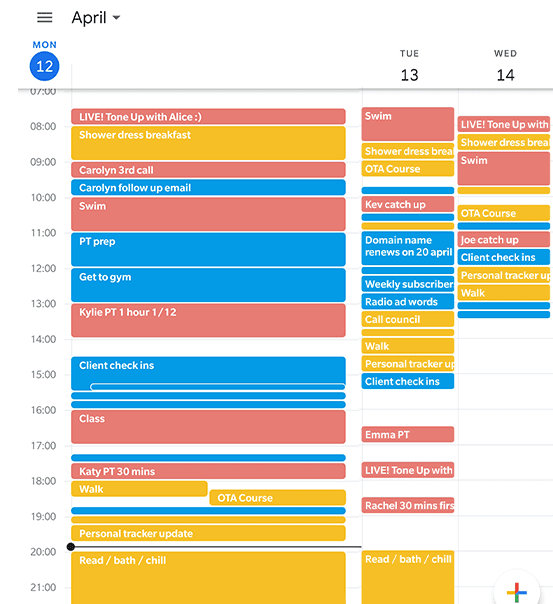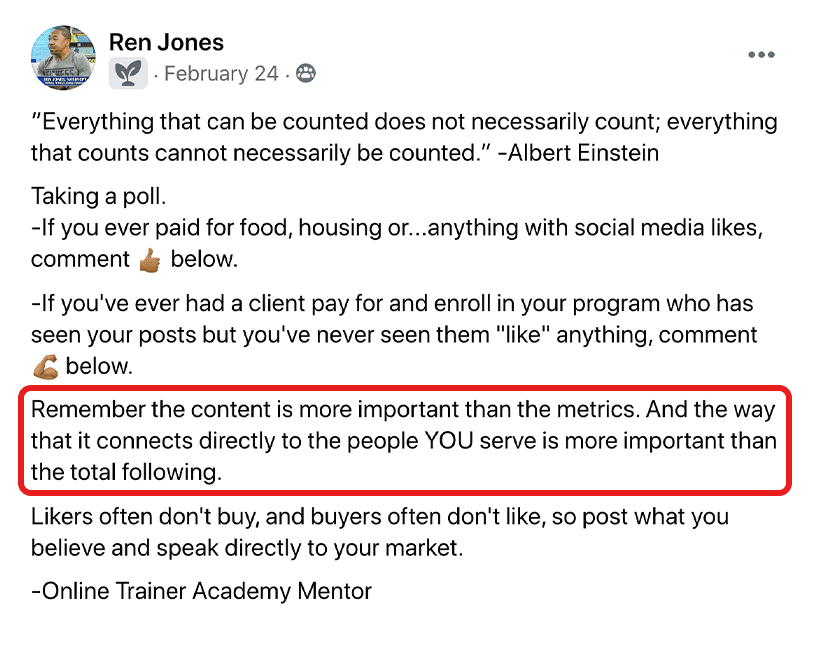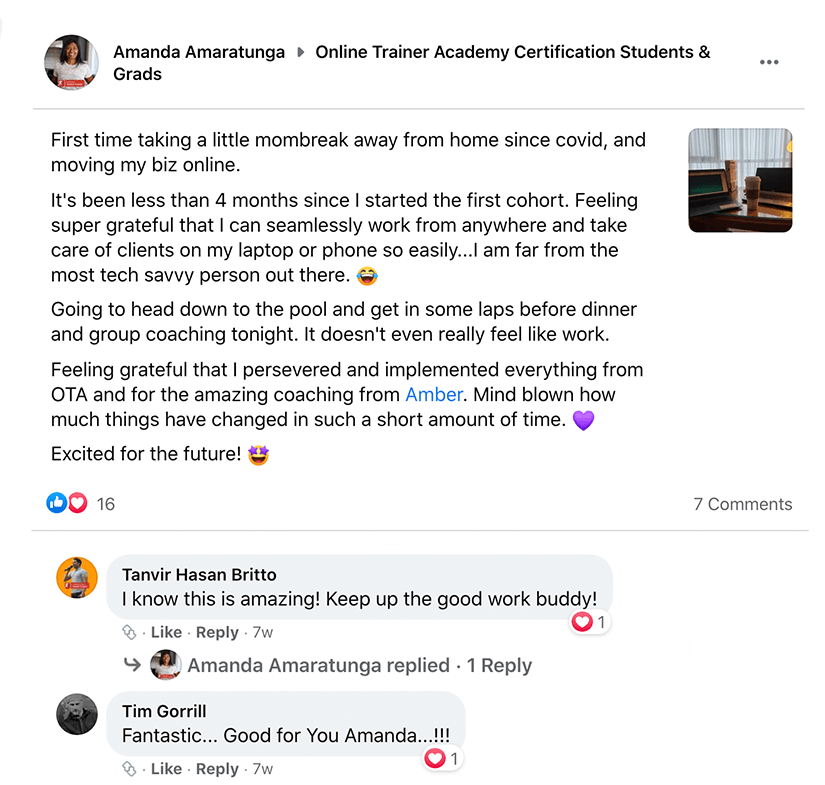Alice Scott wanted the dream. This wasn’t it.
She was working eight-hour shifts training clients one-on-one at a small gym in the south of England.
The hours were decent. She loved helping people.
Just one problem: She wasn’t in control.
Her employer set her hours and pocketed much of the money.
She liked her job. But doing something you love on a schedule you can't control can feel the same as doing something you hate.
A full day of training clients left Scott, an introvert, drained.
So when Scott looked at online personal training—coaching remotely from anywhere you want, on your time—she knew it was for her.
When she started training clients online, she realized she was doing something wrong.
She felt like she always had to be doing something. Responding to clients. Posting on Instagram. Working on her website.
She’d be watching a movie in the evening while working on her application form or posting on social media.
Instead of having more control over her hours, she had no hours at all.
So much for freedom.
It’s a common trap: New online trainers find that they’re working harder than ever, often for less money, than they were when they trained in person. Sound familiar? Here’s what Online Trainer Academy students do …
Trap #1: You must always do “one last thing”
Training clients in person, Scott found, took lots of energy, but at the end of the day she could clock out, go home, and relax.
Now her small flat was her workplace, her kitchen table, her desk. Work and life bled together and she felt constantly “on,” with no day’s-end closure.
Solution: Set boundaries. In the Online Trainer Academy, Scott learned about the Dream Week exercise, where you map out what your ideal week looks like.
Scott uses Google calendar and schedules her week using color-coded time blocks:
- Blue for administrative tasks that can be moved around
- Yellow for relaxing time
- “Flamingo” for fixed appointments like client calls or classes
- Green for her own exercise

She could see her week at a glance—and see if it matched her priorities. “I can look at my week and say, ‘There’s not enough yellow. I don’t like that. What can I change?’”
The colored blocks motivate her. “If there’s a blue task I need to get done that day, and it means I won’t get my bath, that’s going to really annoy me. So I’m like, get it done!”
She’s more intentional with her time. If she schedules 30 minutes to post a nutrition tip on Facebook, she gets it done. Before, she’d tried to do it while watching TV and it’d take way longer.
The result: A controlled workday that starts around 10 a.m. and wraps up by 7 p.m.
By adding structure, Scott feels more free.

Trap #2: You’re constantly hustling to get clients
Nicholas Ng was a college student working as a personal trainer in a chain gym in Malaysia. Classes during the day, training clients until 9 p.m., plus weekends. Within six months he felt maxed out and turned to the Online Trainer Academy.
He had no trouble signing clients for a three-month program. But client care—creating programs, keeping clients accountable, answering questions—dominated his life. He was working just as hard but earning less.
And most of his clients left after three months, so he’d scrounge for more. “I was burning out from the stress,” he says.
Solution: Create a process for retention and referrals.
Ng’s big mistake was not setting expectations.
Retaining clients starts with attracting the right clients in the first place. Ng was posting three times a week on Instagram, but it was all repurposed content from other accounts. Those generic posts didn’t help clients connect with him.
Step one was clarifying his niche: “I help busy working adults lose weight and gain energy without needing strict diets or long workouts.” Now his posts speak directly to this group. He lands clients who are right for him, and it’s easy to remind them why they need him.

Step two is client experience, starting with a welcome package to all his new clients.
Then he sets expectations at the start. He was getting results, but some clients expected more accountability. Now he makes it clear that he takes weekends off and will work on their programs and respond to their messages on weekdays.
He also schedules a checkpoint call around week 6 or 7 of a program so he can celebrate their progress and pitch a renewal.
And he does something obvious that many coaches don’t: Asks for referrals. “Just say, ‘I’m looking to grow my business. Do you happen to know anyone just like you who might benefit from working with me?’” Ng says.
Trap #3: Social media consumes your life!
Social media can be exhausting and might not be worth the time. “Likes” boost your ego, not your bottom line.
Alice Scott recalls this Facebook post from Ren Jones, an Online Trainer Academy mentor:

“That’s just so true,” says Scott. “Everyone is about the likes. It’s about getting out of that mindset.”
Nathalie May, a body and mind coach in Switzerland, recalls being online all the time. She’d spend two or three hours trying to perfect a post, then check obsessively for comments. “And I thought I needed to comment as well to keep engagement on the post,” she says.
Solution: Place limits on your social media—and stick to them.
May uses her iPhone to restrict screen time.
On an iPhone, go to Settings > Screen Time > App Limits to pick which category of apps you want to limit. You’ll get a notification when your limit is about to run out, and once the limit is hit, you’re given the option to extend it by 15 minutes or ignore it.
The Downtime feature (also under Screen Time) cuts off access to all apps (except a few key ones like the phone or Messages) during the time frame of your choosing. (May’s is set from 7:30 p.m. to 7 a.m.)
On an Android: Go to Settings > Digital Wellbeing > Dashboard. Next to the app you want to limit, tap the hourglass icon and select the time limit you want. Press OK. When time’s up, the app icon dims and you won’t be able to open it. To block out all but the most important calls and messages during a set time, go to Digital Wellbeing > Bedtime mode > Do Not Disturb.
“It might sound silly because it’s like a mom telling her five-year-old ‘You shouldn’t watch that much TV!’ But it has helped me a lot,” May says.
Addicted to likes? Listen to this truth that someone gave to May about social media: You are not that important.
“I had to tell myself, people are not actually waiting on their computer to see my post,” May says.
That line also simplified May’s content. “I can just post one sentence and a pic of a glass of water and say ‘Stay hydrated,’ and that’s it! And people love that.”
Trap #4: You want everything to be perfect
Nathalie May spent hours on her application form and joined countless challenges (advertising, creating groups, staying visible), always feeling she needed more education before starting something.
“I thought, ‘I need to have a website, and the perfect Facebook page, and I need to have a Facebook group and the profile pic needs to be beautiful and the description needs to be perfect.’ I was just focusing on all those details, and they weren’t important.”
Solution: Ask yourself, “What would this look like if it were easy?”
That’s one of the foundational mottos of the Online Trainer Academy. May realized that most of her sales happened organically, so she didn’t need that perfect application form.
Everyday chit-chat naturally leads to her mentioning her online training work. “They say ‘Oh, how does that work?’ and then you start the conversation,” May says.
“All of a sudden they sign up and I’m like, what, really? That was so easy!”
This advice has helped Zoe Wong, another trainer in the U.K. She took the advice of her Academy mentor, Ren Jones, to keep it simple. “He said for the first few years of his business, he didn’t even use software, just a spreadsheet. So now I use Google docs and forms, upload videos to YouTube, and then communicate and video-call via WhatsApp.”
Trap #5: You’re paralyzed by decision fatigue
In keeping with the philosophy of the Online Trainer Academy, Amanda Amaratunga took “imperfect” action to get her online business up and running last year in Ottawa.
She built the plane as she was flying it—finding clients, developing a system to care for them, and running the business all at the same time. While being a mom and a veterinarian.
She got bogged down by decisions big and small. “I was getting more and more tired and less effective and efficient,” she says. She found herself working on Thursday and Saturday nights (which had always been her nights off).
“Decision fatigue is real,” Amaratunga says. “There are literally hundreds of decisions you have to make every day. For many of us coaches who are online, it’s just so overwhelming. You don’t know where to focus your energy.”
Solution: Seek support—from the right people.
Amaratunga couldn’t recognize what was happening, let alone know where to start.
She scheduled calls with her Academy mentor, Amber Reynolds (also the Academy director).
She told her that she was starting to get exposure and thought she should promote her upcoming cohort, but was stressing out over how many clients to take on. But she was already overextended. Did she really want more?
Reynolds heard her. “She said, ‘What you’re telling me is you don’t have the energy to deal with more clients,’” Amaratunga recalls. “She said, ‘It’s okay if eight clients are all you can handle.’”
That’s all she needed to hear. Reynolds’s assessment gave her the confidence—the permission—to not take on more clients.
Amaratunga also found support from other coaches through the Online Trainer Academy students and alumni Facebook group.
“We’re all building our businesses up at the same time and going through the same challenges,” she says. They swap ideas and advice.
“When you have the support of other people and they’re, like, ‘You’ve got this. It’s okay,’ then you’re able to make the decisions and commit,” Amaratunga says.
Trap #6: You’re not charging enough
When May started training clients online, she charged $97 per month. Then she did the math and realized that amounted to less than $5 an hour for one client. “That’s not going to pay off,” she says. “I wouldn’t be able to have even 10 clients because I’d be working too much.”
Like many others, she undervalued herself, but found it hard to raise her rate. Moreover, “Asking people to pay me for something I’m passionate about felt wrong.”
Solution: Charge a bit more, a bit at a time.
You forget that what you provide to your clients—a healthier, better life—is probably worth way more than you’re charging.
The Online Trainer Academy suggested she increase her rate incrementally. First, from $97 to $149. Over the following months it increased, and today she charges $329.
She was afraid to say her new price, but the client’s response was: ‘That’s fair. Let’s do it.”
“I was, like, oh great! High-five!”
A simple mindset shift helped her.
“I don’t see it as they’re paying me to make their life easier and healthier. I see it as: They’re paying themselves for their commitment to be healthier,” May explains. “They’re paying to achieve their goals.”
She knows clients understand dieting and workout basics. “Why do they need me? Because they need accountability. Someone who motivates them and reaches out to them. So that’s why they pay me.”
Remember, when clients pay you, they’re buying into their own program. They’ll take it seriously, be more likely to stick with it, and they’ll get good results.
Watch this short video (~2min) for a breakdown of package structure and pricing gone wrong from our founder, Jonathan Goodman.
Trap #7: You think Zoom is enough
Mafs Gonzalez loved her side gig training people in their homes.
She didn’t believe online personal training could work. She felt her clients needed her to be with them.
When COVID hit, she lost her main job and started training a couple of her clients over Zoom from her home gym.
She struggled. She realized she wanted more schedule flexibility and resented feeling “like I’m a puppet and have to be on show.”
Grumpy clients, last-minute cancellations, glitchy connections. ‘Can you see me? Can you hear me?’ It’s like, ugh!” Plus the time limits: “I’m there like, ‘Look, your 45 minutes are kind of done. You wasted 15 minutes trying to set yourself up.’”
“This is not how I want to work,” Gonzales says.
Solution: Set up your online personal training business.
As Gonzalez worked through the Academy and sought guidance from the mentors, she started to see the virtues of online personal training.
She still offers Zoom sessions as part of her services, but by building her online business she’s able to generate revenue in other ways, too.
Plus: She’s able to help more people, she’s able to scale.
By leaning on the mentors, she was able to figure out pricing, packages, and pick up a ton of other tips. For example, using her first online clients to create a Facebook group to help generate leads. Obvious to some, but it wasn’t even on her radar. The group has grown from 10 to 100.
The group helps her connect with people, understand their pains, and ultimately get new clients. “It’s worked!” she says. “It’s like a baby or a Tamagotchi—you have to keep feeding it. You have to care for it. And it’s painful. But now it’s part of my tasks.”
She also invested in personal trainer software (she uses Trainerize) to streamline her training process.
“I realized I’m able to make more of a difference in people’s lives through online coaching,” she says. She’s able to educate people and use habit-based coaching to bring real change to their lives.
“I want to help people live better and longer, not just do a workout,” she says.














